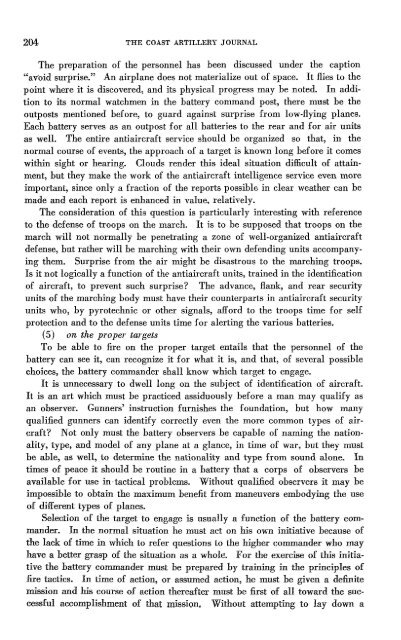THE COAST ARTILLERY JOURNAL - Air Defense Artillery
THE COAST ARTILLERY JOURNAL - Air Defense Artillery
THE COAST ARTILLERY JOURNAL - Air Defense Artillery
Create successful ePaper yourself
Turn your PDF publications into a flip-book with our unique Google optimized e-Paper software.
204 <strong>THE</strong> <strong>COAST</strong> <strong>ARTILLERY</strong> <strong>JOURNAL</strong><br />
The preparation of the personnel has been discussed under the caption<br />
"av'oidsurprise." An airplane does not materialize out of space. It fliesto the<br />
point where it is discovered, and its physical progress may be noted. In addition<br />
to its normal watchmen in the battery command post, there must be the<br />
outposts mentioned before, to guard against surprise from low-flying planes.<br />
Each battery serves as an outpost for all batteries to the rear and for air units<br />
as well. The entire antiaircraft service should be organized so that, in the<br />
normal course of events,the approach of a target is known long before it comes<br />
within sight or hearing. Clouds render this ideal situation difficult of attainment,<br />
but they make the work of the antiaircraft intelligence service even more<br />
important, since only a fraction of the reports possible in clear weather can be<br />
made and each report is enhanced in value, relatively.<br />
The consideration of this question is particularly interesting with reference<br />
to the defense of troops on the march. It is to be supposed that troops on the<br />
march will not normally be penetrating a zone of well-organized antiaircraft<br />
defense,but rather will be marching with their own defending units accompanying<br />
them. Surprise from the air might be disastrous to the marching troops.<br />
Is it not logically a function of the antiaircraft units, trained in the identification<br />
of aircraft, to prevent such surprise? The advance, flank, and rear security<br />
units of the marching body must have their counterparts in antiaircraft security<br />
units who, by pyrotechnic or other signals, afford to the troops time for self<br />
protection and to the defenseunits time for alerting the various batteries.<br />
(5) on the proper targets<br />
To be able to fire on the proper target entails that the personnel of the<br />
battery can see it, can recognize it for what it is, and that, of several possible<br />
choices,the battery commander shall know which target to engage.<br />
It is unnecessary to dwell long on the subject of identification of aircraft.<br />
It is an art which must be practiced assiduously before a man may qualify as<br />
an observer. Gunners' instruction furnishes the foundation, but how many<br />
qualified gunners can identify correctly even the more common types of aircraft?<br />
Not only must the battery observers be capable of naming the nationality,<br />
type, and model of any plane at a glance, in time of war, but they must<br />
be able, as well, to determine the nationality and type from sound alone. In<br />
times of peace it should be routine in a battery that a corps of observers be<br />
available for use in-tactical problems. Without qualified observers it may be<br />
impossible to obtain the maximum benefit from maneuvers embodying the use<br />
of different types of planes.<br />
Selection of the target to engage is usually a function of the battery commander.<br />
In the normal situation he must act on his own initiative because of<br />
the lack of time in which to refer questions to the higher commander who may<br />
have a better grasp of the situation as a whole. For the exercise of this initiative<br />
the battery commander must be prepared by training in the principles of<br />
fire tactics. In time of action, or assumed action, he must be given a definite<br />
mission and his course of action thereafter must be first of all toward the successful<br />
accomplishment of that mission. Without attempting to lay down a
















